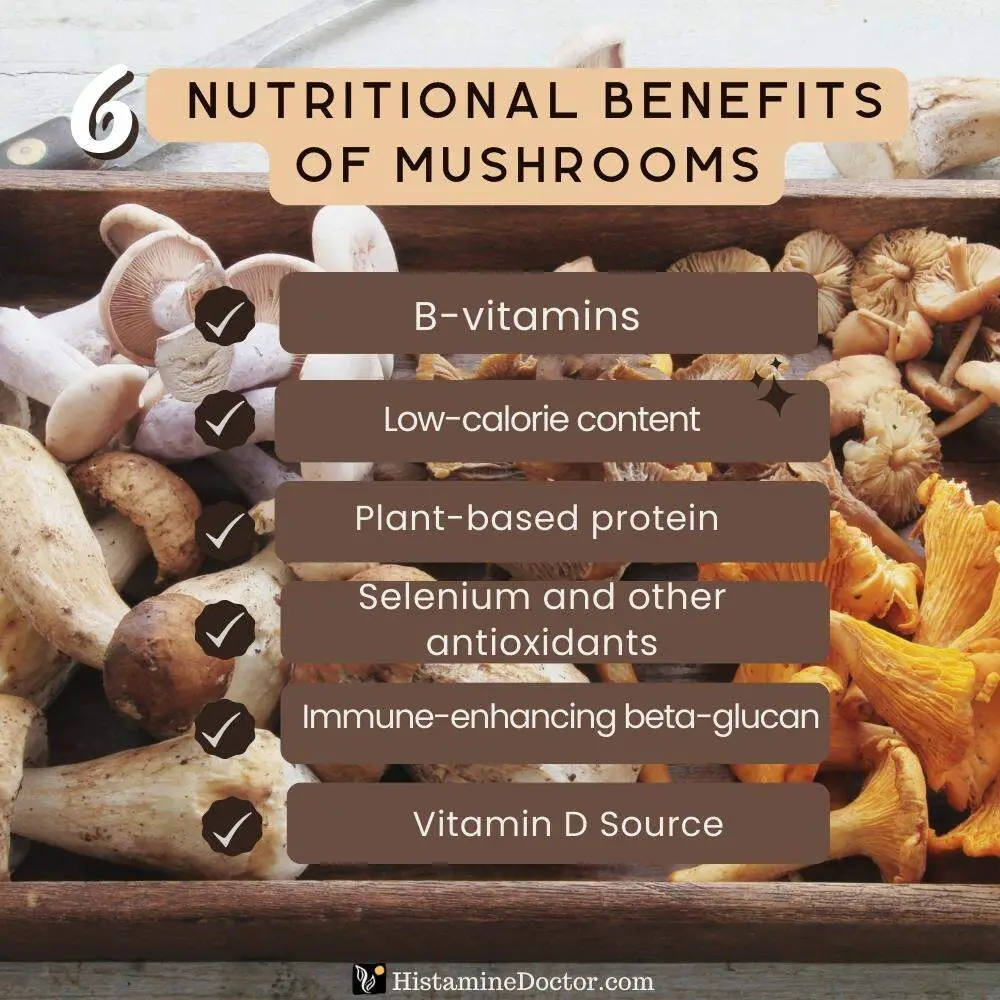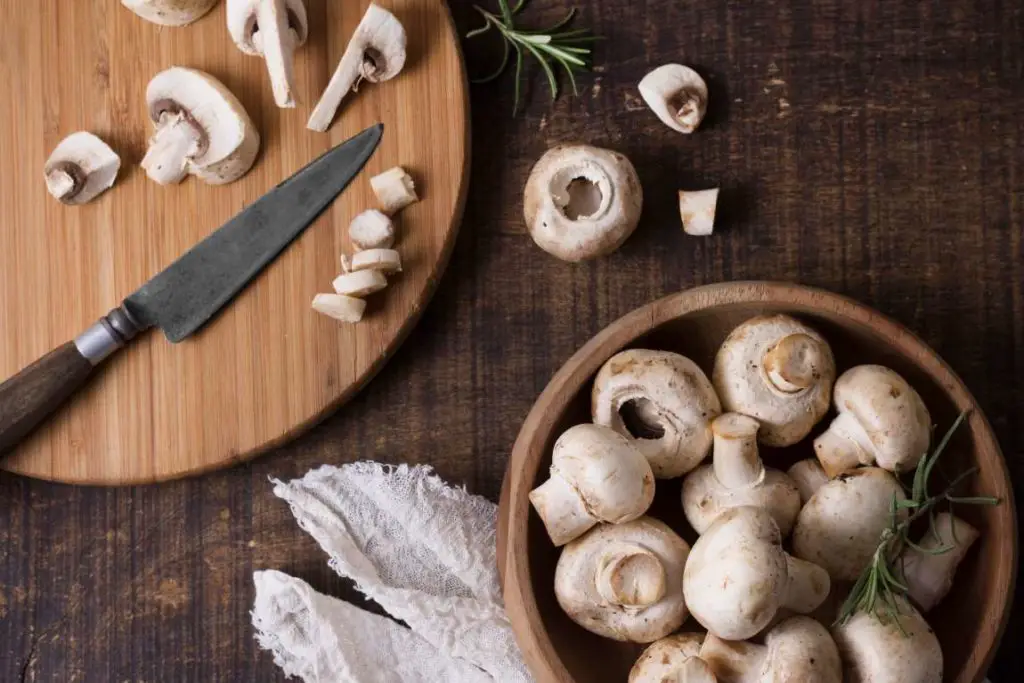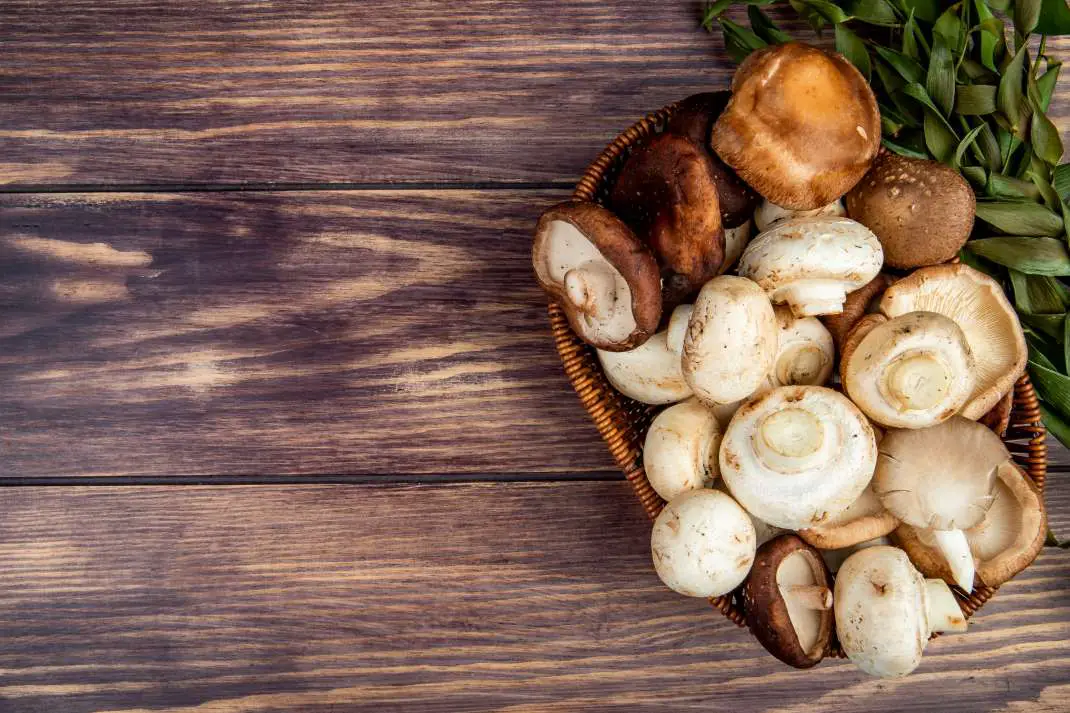Are mushrooms high in histamine? Mushrooms are a fungus that comes from the ground and are not only delicious but also have health benefits.
Mushrooms have a delightful, earthy flavor that works with many types of foods. With so many varieties of mushrooms, there’s lots to choose from.
If you have histamine intolerance, you might wonder whether mushrooms are high in histamine or are histamine liberators. Let’s look more closely at whether mushrooms can be part of a low-histamine diet.
First, we’ll look at their nutritional benefits, and then explore how they stack up in terms of histamine.
The Impact of Mushroom Consumption on Histamine Intolerance
Most healthy people tolerate mushrooms in their diet. But if you have histamine intolerance, you must be aware of everything you eat to avoid overloading your histamine tank and triggering the familiar symptoms of histamine overload.
Histamine sensitivity symptoms often fluctuate with dietary changes, and making smart dietary choices is the best way to control the symptoms
Let’s look at how mushrooms could affect your histamine level. First, we’ll look at their nutritional benefits, and then explore how mushrooms are likely to affect your histamine balance.

Nutritional Benefits of Mushrooms
All mushrooms are low in calories, but still contain a variety of nutrients. A cup of mushrooms supplies 3 grams of plant-based protein and some B-vitamins, making them popular with people who eat a plant-based diet. (6)
Mushrooms are also one of the better plant-based sources of a trace mineral called selenium that has antioxidant activity. (9)
In addition, mushrooms contain other antioxidants that aren’t in many foods, including one called ergothioneine. (10) Antioxidants help fight free radical damage and have anti-inflammatory activity, making them a possible component of an anti-inflammatory diet.
They also contain beta-glucan, a polysaccharide with immune-enhancing activity. Plus, they’re low in calories. (5)
What few people know is that mushrooms are one of the best plant-based sources of vitamin D. When mushrooms soak up the sun’s rays, they produce vitamin D2, a form of vitamin D that helps raise your body’s vitamin D level. (4)
Sun exposure or a vitamin D supplement is the best way to meet your body’s vitamin D requirements. Unfortunately, there are few foods that contain substantial quantities of vitamin D. Mushrooms are an exception.

The Histamine Content of Mushrooms
Like many, but not all, plant-based foods, mushrooms are low in histamine. However, even plant foods that are low in histamine may contain other biogenic amines that can cause problems if you have histamine intolerance.
Therefore, it’s important to be aware of the role other biogenic amines may play in triggering histamine intolerance symptoms.
In one study, researchers measured the quantity of biogenic amines in a variety of plant-based foods. (1) The biogenic amines they measured were histamine, putrescine, cadaverine, tyramine, spermidine, and spermine.
The good news is they detected no histamine in the mushrooms they tested, but that’s not the end of the story. They found significant amounts of putrescine and spermidine, two other biogenic amines. (1)
It’s More Than Just Histamine: Other Biogenic Amines in Mushrooms
If you have high levels of other biogenic amines in a food, even if it’s low in histamine, the other biogenic amines can sometimes trigger histamine intolerance symptoms.
These other biogenic amines compete for and bind to sites that histamine binds to in the intestinal tract. Plus, diamine oxidase (DAO) also breaks these biogenic amines down, so they tie up more diamine oxidase, leaving less available to break down histamine from the other foods you eat.
In the case of mushrooms, the high putrescine content may be problematic if you have histamine sensitivity. Despite being a low-histamine food, people sometimes say mushrooms trigger their histamine intolerance symptoms.
It’s likely that they’re reacting to the putrescine, and to a less degree, spermidine in mushrooms. These biogenic amines are tying up the limited amount of diamine oxidase available.

Do Mushrooms Have Anti-Histamine Properties?
Despite the possible presence of other biogenic amines, certain mushrooms may possess anti-histamine properties. Let’s take a closer look at specific types of mushrooms and how they could affect your histamine level.
Chaga Mushrooms: A Possible Benefit for Histamine Intolerance Symptoms
Chaga mushrooms exhibit minimal histamine levels, with research showing no detectable histamine in this nutrient-rich fungus. However, Chaga mushrooms contain putrescine, another biogenic amine, which, in sufficient quantities, can trigger histamine intolerance symptoms in individuals with low diamine oxidase levels.
To avoid histamine-related issues, it’s advisable to consume Chaga mushrooms right away, as a delay can lead to increased biogenic amine production.
Reishi Mushrooms: Do They Have Antihistamine Properties?
Despite the possible presence of other biogenic amines, certain mushrooms may possess anti-histamine properties. Reishi mushrooms, one of the oldest medicinal mushrooms in the world. are rich in triterpenes known for their anti-histamine and anti-inflammatory properties. (7)
Additionally, immuno-modulating polysaccharides found in Reishi powder can help mitigate an overactive immune response, addressing the root cause of allergies.Some sources point out that they may have the ability to stabilize mast cells, thereby preventing the release of histamine. However, this is an area that hasn’t been adequately researched.
Shiitake: A Flavorful, Low-Histamine Option
Despite their bold flavor profile, shiitake mushrooms are generally low in histamine, making them a suitable choice if you’re following a low-histamine diet. While the biogenic amine content is low, individual reactions can vary based on how the mushrooms are grown and stored.
Shiitake mushrooms are rich in bioactive compounds with both anti-inflammatory and immune-boosting activity. (7) For examples, beta-glucan in Shiitake mushrooms, helps boost immunity against infections. They may help modify immune activity, creating a healthy balance that boosts protection against infections while reducing inflammation. This is an area that needs more research.
Maitake Mushrooms: Do They Affect Histamine Levels?
Maitake mushrooms are commonly used in Japanese and Chinese medicine for their possible immune-boosting benefits. However, this is an area that hasn’t been well researched.
I would approach maitake mushrooms until we know more about its biogenic amine content and how it affects histamine levels, as there are few studies looking at their biogenic amine content.
White Button Mushrooms: Are They High in Histamine?
White button mushrooms are the most common mushrooms you find at the supermarket. Fortunately, they’re low in histamine.
One study that analyzed a limited number of white button mushroom samples found no histamine in the tested samples.(8) However, they did find modest quantites of other biogenic amines, including permidine, putrescine, and tyramine. However, they didn’t deem the amounts ot be risky from a health standpoint.
But keep in mind, the histamine content and the quantity of other biogenic amines can vary based on how samples are grown, harvested and stored. This is true of all types of mushrooms.
Allergies to Mushrooms
Although not common, some people are sensitive to mushrooms, in a classic food allergy sense. (2) When they eat, inhale, or even touch mushrooms, immune cells release histamine. That’s not what you want if you have histamine intolerance.
It’s not clear how common mushroom allergy is but it can sometimes show up even if you’ve been eating mushrooms for years without problems.
Avoiding Histamine Intolerance Symptoms When You Eat Plant-Based Foods and Mushrooms
Avoid plant-based foods that are high known to be high in histamine if you have histamine intolerance, but you also may need to limit foods that contain other biogenic amines, like mushrooms.
If you eat these foods, choose only the freshest sources since biogenic amines, including histamine, may form during refrigeration. (1) In some cases, this may be due to bacterial contamination. On the plus side, refrigeration slows production of biogenic amines. (3)
Here are some other tips for consuming safely on a low-histamine diet:
- Quick Cooking: Opt for quick cooking methods like sautéing in olive oil at high heat, as this can limit histamine formation.
- Avoid Fermentation: While fermented foods offer numerous health benefits, they are typically high in histamines. Avoid fermented mushrooms.
- Proper Storage: If you don’t intend to consume mushrooms immediately, store them in a cool, dry place or refrigerate them to slow histamine production.
- Cook at Home: Preparing mushrooms at home grants you greater control over their freshness and preparation methods, which can help minimize histamine-related issues.
- Monitor Your Response: Add mushrooms slowly to your diet and note how your body responds.
The Bottom Line
Are mushrooms high in histamine? Mushrooms are low in histamine, based on current studies, but there may be other biogenic amines in these nutrient-dense fungi. For example, mushrooms contain putrescine and spermidine in amounts high enough to cause histamine intolerance symptoms if you have a low level of diamine oxidase. (1)
As with other foods that contain biogenic amines, you may do fine with small quantities of mushrooms if you don’t have a severe deficiency of diamine oxidase and you don’t consume other high-histamine foods or foods that trigger histamine release. It’s about the totality of your diet rather than a single food.
If you experiment with mushrooms in your diet, make sure they’re fresh and don’t store them in your refrigerator for more than a day to ensure they don’t produce more biogenic amines during storage. Continue to keep a food journal so you can track whether your symptoms change if you eat a new food.
References:
- Sánchez-Pérez, S., Comas-Basté, O., Rabell-González, J., Veciana-Nogués, M. T., Latorre-Moratalla, M. L., & Vidal-Carou, M. C. (2018). Biogenic Amines in Plant-Origin Foods: Are They Frequently Underestimated in Low-Histamine Diets?. Foods (Basel, Switzerland), 7(12), 205. https://doi.org/10.3390/foods7120205.
- Koivikko A, Savolainen J. Mushroom allergy. Allergy. 1988 Jan;43(1):1-10. doi: 10.1111/j.1398-9995.1988.tb02037.x. PMID: 3278649.
- Naila, A., Flint, S., Fletcher, G., Bremer, P., & Meerdink, G. (2010). Control of biogenic amines in food–existing and emerging approaches. Journal of food science, 75(7), R139–R150. https://doi.org/10.1111/j.1750-3841.2010.01774.x.
- Cardwell G, Bornman JF, James AP, Black LJ. A Review of Mushrooms as a Potential Source of Dietary Vitamin D. Nutrients. 2018 Oct 13;10(10):1498. doi: 10.3390/nu10101498. PMID: 30322118; PMCID: PMC6213178.
- Chen, S. N., Chang, C. S., Hung, M. H., Chen, S., Wang, W., Tai, C. J., & Lu, C. L. (2014). The Effect of Mushroom Beta-Glucans from Solid Culture of Ganoderma lucidum on Inhibition of the Primary Tumor Metastasis. Evidence-based complementary and alternative medicine : eCAM, 2014, 252171. https://doi.org/10.1155/2014/252171.
- USDA (U.S. Department of Agriculture. “Mushrooms, White, Raw” https://fdc.nal.usda.gov/fdc-app.html#/food-details/169251/nutrients
- Venturella G, Ferraro V, Cirlincione F, Gargano ML. Medicinal Mushrooms: Bioactive Compounds, Use, and Clinical Trials. Int J Mol Sci. 2021 Jan 10;22(2):634. doi: 10.3390/ijms22020634. PMID: 33435246; PMCID: PMC7826851.
- E. Jabłońska-Ryś, A. Sławińska, Skrzypczak K, Kowalczyk D, Stadnik J. Content of Biogenic Amines and Physical Properties of Lacto-Fermented Button Mushrooms. Applied Sciences. Published 2022. Accessed September 13, 2023. https://www.semanticscholar.org/paper/Content-of-Biogenic-Amines-and-Physical-Properties-Jab%C5%82o%C5%84ska-Ry%C5%9B-S%C5%82awi%C5%84ska/0b1cdccf4b4656ca26b091f50787be1856e0e495. https://www.mdpi.com/2076-3417/12/18/8957
- Battin EE, Perron NR, Brumaghim JL. The central role of metal coordination in selenium antioxidant activity. Inorg Chem. 2006 Jan 23;45(2):499-501. doi: 10.1021/ic051594f. PMID: 16411681.
- Beelman RB, Phillips AT, Richie JP Jr, Ba DM, Duiker SW, Kalaras MD. Health consequences of improving the content of ergothioneine in the food supply. FEBS Lett. 2022 May;596(10):1231-1240. doi: 10.1002/1873-3468.14268. Epub 2022 Jan 10. Erratum in: FEBS Lett. 2022 Sep;596(18):2465. PMID: 34954825.

